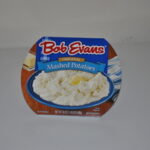There are few things better during the holidays than hot gravy on buttery mashed potatoes, thick gravy spooned over turkey at Thanksgiving, or homemade gravy ladled over cornbread stuffing. Although there are many varieties of store-bought gravy on the market, nothing tastes quite like homemade. People tend to think homemade gravy is a difficult task, but it’s indeed an easy endeavour for most people who are even a little bit at ease in a kitchen. There are a couple of key components in any homemade gravy. Whether you like it lumpy and think or smooth and runny, gravy almost always begins with a simple roux.
What is a roux? A traditional roux is a mixture of flour and fat, heated in a medium skillet until very light golden brown (but not burnt. The first step in making homemade gravy is to make a simple roux. The fat gives the gravy depth and the flour helps to act as the thickener. Many people use clarified butter as the fat component in their roux, although if making a meat gravy, one could use the fat drippings from the turkey, chicken, or ham they’re preparing. Simply pour the fat drippings in a heavy saucepan with enough flour to thicken it and stir over medium heat until golden. It is very important not to burn the roux or your gravy will taste bitter!
When the roux is thick, water or broth is added slowly to thin the gravy to the consistency desired. Broth will add a lot of flavor and few additional spices will be needed (though you can salt and pepper to taste). You can use store-brought turkey broth to make turkey gravy, chicken stock for chicken gravy, and so on. If making a vegetarian gravy, vegetable broth adds flavor to gravy and clarified butter can be used as the fat element in the roux (as opposed to fat drippings).
A variety of spices can then be added to create a more flavorful gravy. Spices that go well with turkey gravy or chicken gravy include parsley, sage, rosemary, thyme, onion, and a bit of garlic. If serving a roast, liquid smoke tastes wonderful in meat gravy and adds tremendous flavor. If serving ham, a bit of clove spice and a small splash of pineapple juice makes a delicious gravy.
For lumpy gravy, the roux can be stirred with a spoon once the liquid is slowly. Some of the flour will remain in ‘lumps’ that some people prefer in their gravy. For smooth gravy with no lumps, a wire whisk or a hand-held mixer does the trick.
Homemade gravy is quite salty and fatty, however if you’re watching your figure, you can opt for less sodium and lower fat, making the roux with vegetable broth and flour rather than a lot of butter or fat drippings.
Whether you like lumpy gravy, turkey, chicken or veggie gravy, smooth and runny, low-fat or smoky gravy, no one can deny this holiday staple makes any holiday table complete.



